
Antechinus

Antechinus /æntɪˈkaɪnəs/ ('ant-echinus') is a genus of small dasyurid marsupial endemic to Australia. They resemble mice with the bristly fur of shrews. They are sometimes also called broad-footed marsupial mice, pouched mice, route rat and/or Antechinus shrews. However, these common names are considered either regional or archaic and the modern common name for the animals is Antechinus. Antechinus have short fur and are generally greyish or brownish in colour, this varies with species. The fur is dense and generally soft. Their tails are thin and tapering and range from slightly shorter to slightly longer than body length. Their heads are conical in shape and ears are small to medium in size. Some species have a relatively long, narrow snout that gives them a shrew like appearance. Species vary from 12–31cm in length and weigh 16–170 g when fully grown. A. agilis is the smallest known species, and A. swainsonii the largest. Sexual dimorphism occurs in most species for both weight and skeletal measurements, with males being typically larger and heavier. Most species nest communally in tree-hollows. They primarily inhabit all forests, woodlands and rainforest as well as heaths and grasslands in some species. The majority of Antechinus species are located on the eastern coast of Australia along the Great Dividing Range. There is a population of A. flavipes in south west Western Australia. A. bellus lives in northern Australia around the Gulf of Carpentaria. There are currently 15 recognised species of Antechinus with a number of sub species. A few species of New Guinean Antechinus were recognised however these have been reclassified into the genus Murexia. The interspecific relations of the genus Antechinus are still under review. The currently accepted phylogeny is the presence of four clades within the Antechinus genus. The clades generally are formed by species with similar geographic distributions.
